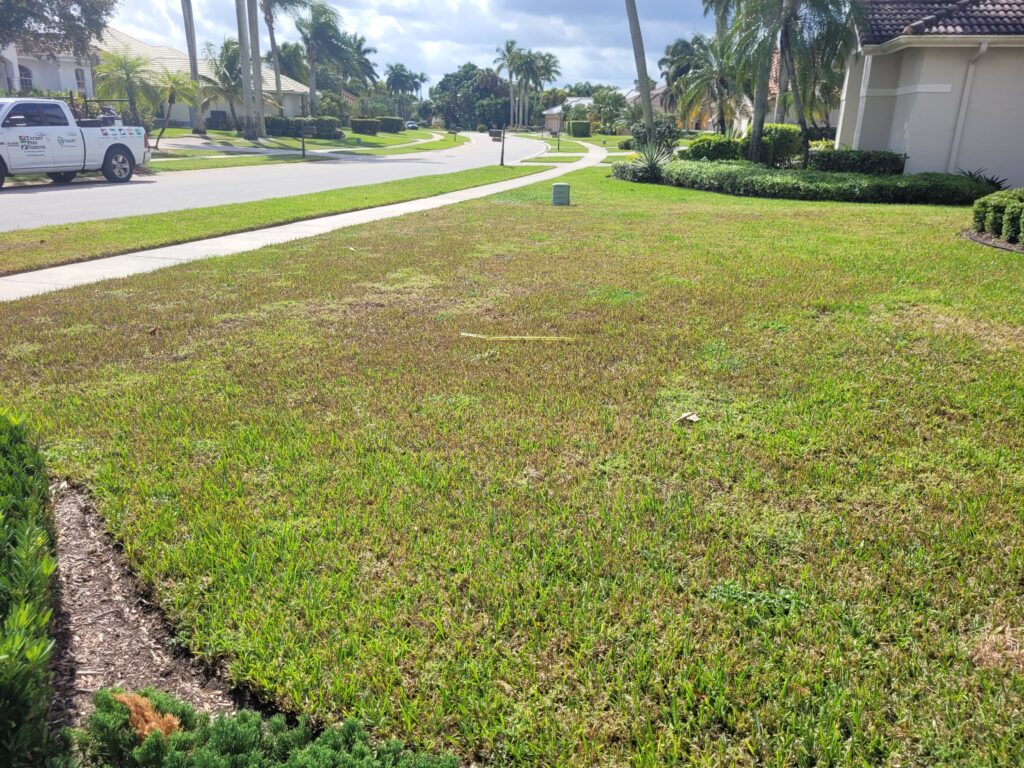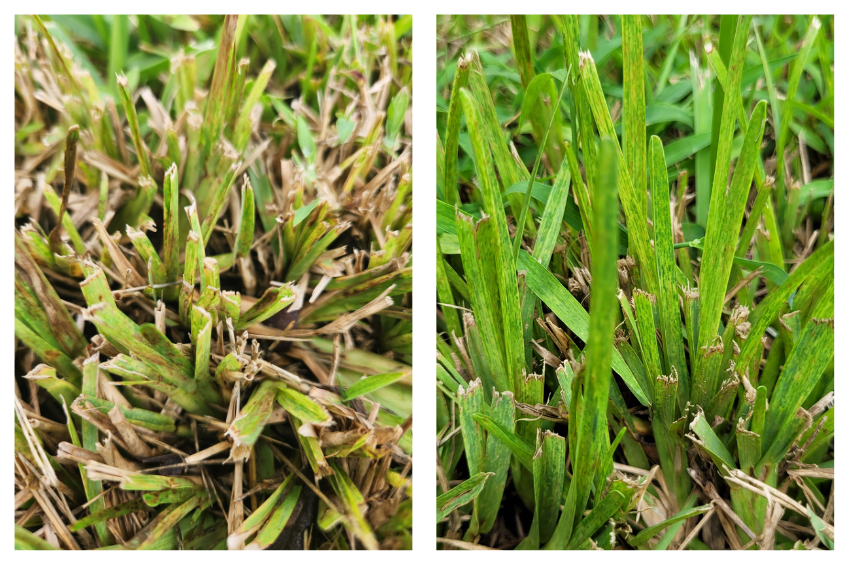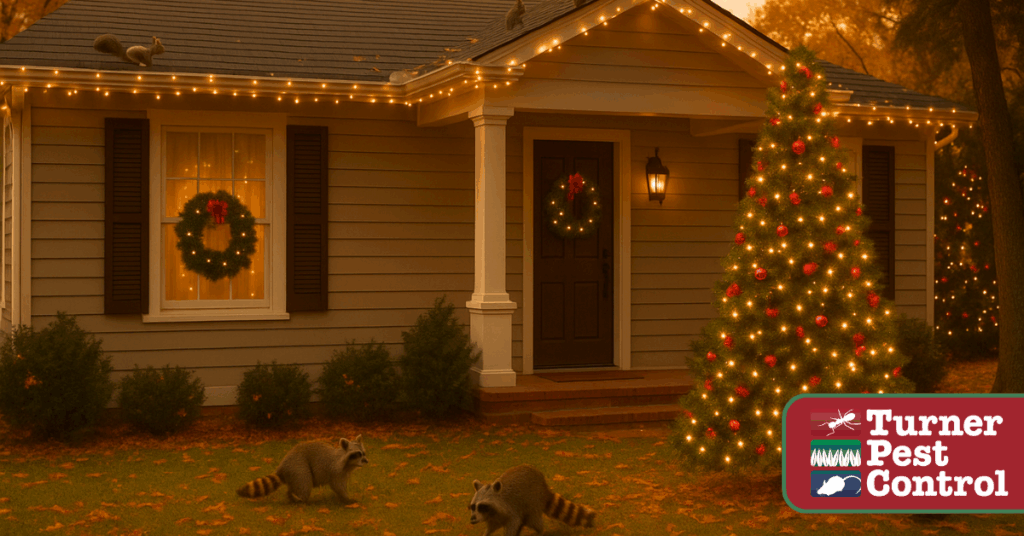
Florida lawns face their share of challenges: droughts, chinch bugs, fungus outbreaks...but one lesser-known threat has really begun to spread: Lethal Viral Necrosis (LVN). Among Florida lawn diseases, few have gained attention recently like Lethal Viral Necrosis (LVN) — a destructive St. Augustine grass virus spreading across the state.
This turfgrass disease has been reported in multiple areas across the state and causes irreversible decline in certain types of St. Augustine grass, especially the Floratam variety. Here’s what property owners, landscape managers, and lawn professionals should know.
What Is Lethal Viral Necrosis?
Lethal Viral Necrosis (LVN) is a virus-driven disease that affects St. Augustine grass. It develops when a grass plant is infected with the Sugarcane Mosaic Virus (SCMV) causing the turf to deteriorate over the course of a few years and die off.
The disease is spread through lawn maintenance equipment (mowers and trimmers) and sometimes Aphids that carry the virus between lawns. Once LVN takes hold, the affected grass can’t recover and ultimately will need to be replaced.
According to the UF/IFAS Palm Beach County Extension Fact Sheet (February 2024), LVN has been confirmed in Palm Beach and other counties throughout the state for Florida.

How to Identify Lethal Viral Necrosis in Florida Lawns
LVN can sometimes look like other common lawn diseases, so it’s important to know the key symptoms:
- Yellowing or mottled leaves (patchy light and dark green areas)
- Discoloration of the blades of grass will appear in a mosaic pattern.
- Turf color can be a lighter green in the early phases and progresses to yellow and brown as the turf continues to fail.
- Turf doesn’t respond to fertilizer applications, especially during cooler months.

Early stage symptoms of LVN
Photo: UF IFAS Extension - University of Florida P. Harmon

Later-stage symptoms of LVN
Photo: UF IFAS Extension - University of Florida P. Harmon
Why Lethal Viral Necrosis Is a Major Threat to Florida Lawns
Floratam St. Augustine grass is the one cultivar that LVN kills. Floratam is the most popular turfgrass type in the state of Florida, meaning many residential, commercial, and HOA properties are at risk.
Other varieties such as Citrablue and Palmetto are the cultivars most recommended to be used to replace infected Floratam. Early detection and management are key to minimizing replacement costs and protecting surrounding lawns.
What to Do if You Suspect LVN: Next Steps for Florida Homeowners
Unfortunately, there’s no treatment or chemical cure for LVN. Once infected, affected areas must be removed and replaced with healthy sod. Here’s how to manage it:
- Confirm the diagnosis – Work with a Turner Lawn Specialists or your local UF/IFAS Extension office to determine whether the issue is truly LVN or another turf problem. (Extension offices are county-based resources run by the University of Florida that help diagnose plant and turf diseases and can send samples for testing if needed.)
- Avoid spreading it – Clean mowers, trimmers, and edging tools between properties or lawn sections.
- Replace wisely – Choose alternative St. Augustine grass varieties with greater tolerance, such as CitraBlue or Palmetto.
- Practice prevention – Maintain proper mowing height, avoid overfertilizing, and manage irrigation to keep turf healthy and resilient.

Think Your Lawn Has Lethal Viral Necrosis? Here’s What to Do
If you’re seeing unusual discolorations such as lighter green patches or a dull bronze appearance, it’s important to confirm the cause. Turner’s lawn specialists can inspect your property and rule out other common turf issues like large patch fungus that can mimic the early signs of LVN.

Our lawn and outdoor pest control team can help you identify what is happening and recommend the best next steps to protect your landscape investment.
Frequently Asked Questions (FAQs)
Q: Can LVN spread from my neighbor’s yard to mine?
Yes, especially if shared equipment or landscaping crews move between properties without cleaning their tools.
Q: Is there any chemical I can apply to stop LVN?
No. There are no fungicides, pesticides, or lawn treatments that stop the virus once it infects the grass.
Q: Should I remove my entire lawn if just a small patch is infected?
In the early stages, spot removal may help, but complete removal is often necessary for Floratam lawns since the virus could have spread farther, but the symptoms are not visible yet.
Q: Are the symptoms going to be visible all year long?
Yes. The symptoms are less noticeable in the summer months as the higher temperatures help the grass to grow, and that helps hide the visual effects. Once the temperature drops down a little the symptoms will quickly become visible again
Q: How can Turner Pest Control help fight against lethal viral necrosis in your lawn?
We offer full-service lawn care, including disease diagnosis, pest management, turf replacement recommendations, and long-term lawn health strategies. Learn more about our Lawn and Outdoor Pest Control services here.
Source: All information in this blog is based on research from the UF/IFAS Palm Beach County Extension Fact Sheet (February 2024)



